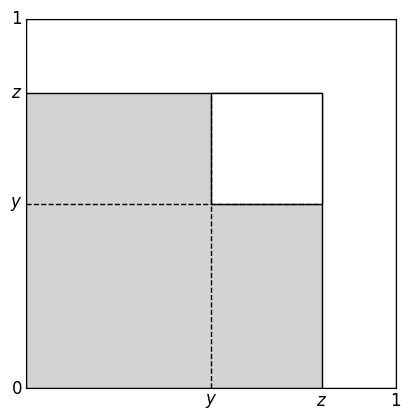Correlation of max and min#
Given \(n\) iid Uniform(0, 1) variables \( X_1 \dots X_n\), denote min as \(Y\) and max as \(Z\)
Min-max expectation#
Clearly
Not hard to see that \(P(Y\leq y) = 1 - (1-y)^n \) and \( E[Y] = \frac{1}{n+1}\) similarly
#
We are now interested in conditional distribution \(P(Y \leq y \mid Z \leq z) \)
First consider \(X_1, X_2 \sim \text{iid}\) \(\text{Unif}(0, 1)\), and \(Y = \min(X_1, X_2), Z = \max(X_1, X_2) \)
Clearly \(P(Y\leq y) = 1 - (1-y)^2 \) and \(P(Z \leq z) = z^2\)
When considering \( P(Y > y \mid Z \leq z) \), consider the plot below, where both axis are independent Unif(0, 1)
Obviously if \(y > z\), this probability would be 0 as we must have \( Y \leq Z\). Assuming \(y < z\):
We can see that \(P(Y > y, Z \leq z) = (z-y)^2\), and that \(P(Y \leq y, Z \leq z) = z^2 - (z-y)^2\),
Hence
which is the grey area below
import matplotlib.pyplot as plt
import matplotlib.patches as patches
y,z = 0.5, 0.8
fig, ax = plt.subplots()
unit_square = patches.Rectangle((0, 0), 1, 1, edgecolor='black', facecolor='white')
ax.add_patch(unit_square)
square_z = patches.Rectangle((0, 0), z, z, edgecolor='black', facecolor='lightgray')
ax.add_patch(square_z)
square_y = patches.Rectangle((y, y), z-y, z-y, edgecolor='black', facecolor='white')
ax.add_patch(square_y)
ax.plot([y, y], [0, z], color='black', linestyle='--', linewidth=1)
ax.plot([0, z], [y, y], color='black', linestyle='--', linewidth=1)
ax.set_xlim(0, 1)
ax.set_ylim(0, 1)
ax.set_aspect('equal')
ax.set_xticks([])
ax.set_yticks([])
ax.text(y, -0.01, r'$y$', ha='center', va='top', fontsize=12, clip_on=False)
ax.text(z, -0.01, r'$z$', ha='center', va='top', fontsize=12, clip_on=False)
ax.text(-0.01, y, r'$y$', ha='right', va='center', fontsize=12, clip_on=False)
ax.text(-0.01, z, r'$z$', ha='right', va='center', fontsize=12, clip_on=False)
ax.text(1, -0.01, r'$1$', ha='center', va='top', fontsize=12, clip_on=False)
ax.text(-0.01, 0, r'$0$', ha='right', va='center', fontsize=12, clip_on=False)
ax.text(-0.01, 1, r'$1$', ha='right', va='center', fontsize=12, clip_on=False)
plt.grid(False)

Now one would expect that with \(n\) iid \(X_i\), we would have
Let’s check below
y,z = 0.1, 1
n = 5
(z**n - (z-y)**n) / z**n
0.40950999999999993
import numpy as np
N_sim = 1000000 # Number of simulations
X = np.random.uniform(0, 1, size=(N_sim, n))
Y = np.min(X, axis=1)
Z = np.max(X, axis=1)
prob_YZ = np.mean((Y <= y) & (Z <= z))
prob_Z = np.mean(Z <= z)
print(f"P(Y ≤ {y} | Z ≤ {z}) ≈ {prob_YZ / prob_Z:.4f}")
P(Y ≤ 0.1 | Z ≤ 1) ≈ 0.4091
# another way to simulate
A,B = 0,0
for _ in range(100000):
X = np.random.uniform(0, 1, size=(n,))
if np.max(X) <= z:
B += 1
if np.min(X) <= y:
A += 1
print(f"P(Y ≤ {y} | Z ≤ {z}) ≈ {A / B:.4f}")
P(Y ≤ 0.1 | Z ≤ 1) ≈ 0.4078
Correlation#
To compute Corr(\(Y, Z\)), again first consider \(n=2\) case. We have
For \(n=2\), we clearly have \( E[YZ] = E[X_1] E[X_2] = 1/4\), and recall we have \( E[Y] = 1/3\) and \( E[Z] = 2/3\).
Recall \( F(z) = z^2\) so \(f(z) = 2z\), and \(F(y) = 1-(1-y)^2\) so \(f(y) = 2(1-y)\)
Hence we have \( E[Z^2] = \int z^2 (2z) dz = 2/4 \), so \(\text{Var}(Z) = 1/2 - (2/3)^2 = 1/18\)
Similarly \(\text{Var}(Y) = 1/6 - (1/3)^2 = 1/18\) (we can claim so by symmetry)
Plugging in, we have
n IID min-max corr#
In fact, we can say that for \(n\) iid Uniform, \(\text{corr}(Y, Z) = \frac{1}{n} \)
First recall
We note that for $y \in [0, z]:
Still we consider \(n=2\) first, then
and
Note we have \( \int_0^z f(y|z) dy = 1\) so this is a valid density of \(y\)
Now \(\mathbb{E}[Y \mid Z] = \int y \; f(y|z) dy = \int_0^z \frac{y}{z} dy = \frac{1}{z} \frac{z^2}{2} = \frac{z}{2} \)
We claim that in general, given the maximum \(Z = z \in (0,1)\), the rest of the order statistics should be evenly spaced in between \((0, z)\) in expectation.
Specifically, since there are \(n - 1\) uniforms left, the expected order statistics should be \(\frac{1}{n}z, \frac{2}{n}z, \ldots, \frac{n - 1}{n}z\). Then
We have
Then
